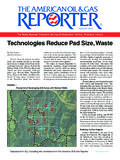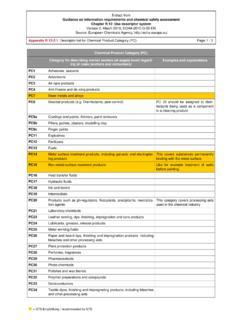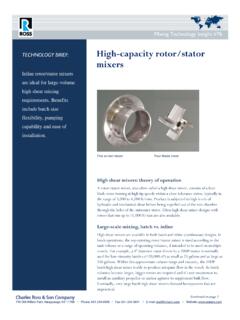Transcription of TECHNICAL SUMMARY OF OIL & GAS PRODUCED …
1 TECHNICAL SUMMARY OF OIL & GAS PRODUCED WATER TREATMENT TECHNOLOGIES J. Daniel Arthur, Bruce G. Langhus, , Chirag Patel ALL CONSULTING, LLC 1718 South Cheyenne Ave., Tulsa, OK 74119 Ph: 918 382 7581 Fax: 918 382 7582 Abstract The objectives of oil and gas PRODUCED water treatment include meeting discharge regulations (local, state and federal), reusing treated PRODUCED water in oil and gas operations, developing agricultural water uses, rangeland restoration, cattle and animal drinking water, water for human consumption, and meeting water quality requirements for miscellaneous beneficial uses. Current PRODUCED water technologies and their successful applications have advantages and disadvantages and can be ranked on the basis of those factors. This paper attempts to describe, summarize and analyze various PRODUCED water treatment systems developed by oil and gas producers, research organizations, water treatment service companies, and universities.
2 Treatment technologies, furthermore, have applicability to different kinds of PRODUCED water from strong brines to brackish waters. Acknowledgements This paper was done as part of a research project funded by the National Energy Technology Laboratory (NETL) of the US Department of Energy (DOE). ALL Consulting and the Interstate Oil and Gas Compact Commission (IOGCC) as co-researchers are joined by the cooperating oil and gas agencies of several oil and gas producing states. The authors wish to thank the DOE and our co-researchers for their support. _____ March 2005 ALL Consulting, LLC 1 Introduction Water PRODUCED during oil and gas extraction operations constitutes the industry s most important waste stream on the basis of volume. The oil and gas industry produces approximately 14 billion bbls of water annually [1, 2]. The water varies greatly in quality and quantity and in some cases the water can be a useful by-product or even a salable commodity.
3 PRODUCED water is most often considered a waste, but the industry is beginning to consider this material as a potential profit stream. Whether waste or commodity, PRODUCED water has management costs that need to be kept in-line with each specific production project and region or it could adversely affect the life of the well, thereby leaving substantial recoverable reserves in the ground. PRODUCED water handling practices must also be environmentally protective or the operator could face regulatory action. PRODUCED water handling methodology depends on the composition of PRODUCED water, location, quantity and the availability of resources. Some of the options available to the oil and gas operator for managing PRODUCED water might include the following: 1. Avoid production of water onto the surface Using polymer gels that block water contributing fissures or fractures or Downhole Water Separators which separate water from oil or gas streams downhole and reinject it into suitable formations.
4 This option eliminates waste water and is one of the more elegant solutions, but is not always possible. 2. Inject PRODUCED water Inject the PRODUCED water into the same formation or another suitable formation; involves transportation of PRODUCED water from the producing to the injection site. Treatment of the injectate to reduce fouling and scaling agents and bacteria might be necessary. While waste water is generated in this option, the waste is emplaced back underground. 3. Discharge PRODUCED water Treat the PRODUCED water to meet onshore or offshore discharge regulations. In some cases the treatment of PRODUCED water might not be necessary. 4. Reuse in oil and gas operations Treat the PRODUCED water to meet the quality required to use it for drilling, stimulation, and workover operations. 5. Consume in beneficial use In some cases, significant treatment of PRODUCED water is required to meet the quality required for beneficial uses such as irrigation, rangeland restoration, cattle and animal consumption, and drinking water for private use or in public water systems.
5 Treatment of PRODUCED water has been attempted and is proven to be an effective option for PRODUCED water handling. Studies conducted to identify, verify and compile existing and newly developed techniques demonstrate the economical benefits of PRODUCED water treatment. Treating oilfield water can help facilitate additional water management options for operators such as beneficial uses that in the short and long term can potentially provide certain community and economic advantages. Treated PRODUCED water has the potential to be a valuable product rather than a waste. The treatment of PRODUCED water is a necessity before the majority of the conventional PRODUCED waters can be applied to ALL Consulting, LLC 2 other uses. The general objectives for operators when they plan PRODUCED water treatment are: 1. De-oiling Removal of free and dispersed oil and grease present in PRODUCED water. 2. Soluble organics removal Removal of dissolved organics.
6 3. Disinfection Removal of bacteria, microorganisms, algae, etc. 4. Suspended solids removal Removal of suspended particles, sand, turbidity, etc. 5. Dissolved gas removal Removal of light hydrocarbon gases, carbon dioxide, hydrogen sulfide, etc. 6. Desalination or demineralization Removal of dissolved salts, sulfates, nitrates, contaminants, scaling agents, etc. 7. Softening Removal of excess water hardness. 8. Sodium Adsorption Ratio (SAR) adjustment Addition of calcium or magnesium ions into the PRODUCED water to adjust sodicity levels prior to irrigation. 9. Miscellaneous Naturally occurring radioactive materials (NORM) removal. Selection of PRODUCED water treatment structure is often a challenging problem that is steered by the overall treatment objective. The general plan is to select the cheapest method preferably mobile treatment units which assure the achievement of targeted output criteria.
7 In this way technology can be positioned in the field for optimum convenience and the technology can be fine-tuned to meet specific end-uses for the water. The following sections discuss the major objectives of PRODUCED water treatment, the technology alternatives commercially available at the present time, and a SUMMARY of the advantages and disadvantages of the various technologies. ALL Consulting, LLC 3 PRODUCED Water Treatment Objectives PRODUCED water usually represents a waste product in the petroleum industry; it is more often than not only a cost that must be controlled to enhance project economics. Water management and cost control can be done by choosing appropriate water disposal options or by finding an appropriate beneficial use for the water. Waste options and beneficial uses are, however, highly dependent upon water quality and may require water treatment prior to disposal or use.
8 Treatment of PRODUCED water may be required in order to meet pre-disposal regulatory limits or to meet beneficial use specifications. If the oil and gas operator aims to utilize a low-cost disposal option such as discharge to surface waters, the PRODUCED water must meet or exceed limits set by regulators for key parameters. The parameters might be specific constituents of concern such as ammonia or barium that can be toxic to sensitive animal and plant-life. Or the parameters may be more broadly-based such as Total Dissolved Solids (TDS) or Sodium Adsorption Ratio (SAR) that can affect several aspects of the environment. The regulatory community may make these limits seasonal so that spring run-off water is more carefully protected. In that case treatment options may also be seasonal. If the oil and gas operator wishes to convey his PRODUCED water to a secondary user, the operator must be sure that the water falls within the specifications of the user.
9 Specifications might be chemical ( , TDS), physical (temperature), or biological (coliforms per L). Specifications, regulatory limits and PRODUCED volume will define treatment objectives for the operator. PRODUCED water treatment objectives may be mandated for several reasons and may be made necessary because of the presence of a number of constituents. The section below discusses some of these common treatment objectives. Oil and Grease Removal (De-oiling) Oil and grease in PRODUCED water includes free oil, dispersed oil (small oil droplets), and emulsified oil. Oil and grease discharge, along with PRODUCED water, involves compliance with stringent regulations. For example, monthly average oil content of 29 ppm (analyzed by EPA 1664 A) in dischargeable PRODUCED water is allowed for offshore operations in the Gulf of Mexico. Oil and grease removal methods depend on the end usage of treated water and composition of oil in the PRODUCED water.
10 Table 1 [2] shows typical performance for oil removal treatment as expressed by oil particle size. ALL Consulting, LLC 4 Table 1 Oil and grease removal technologies based on size of removable particles. Oil Removal Technology Minimum size of particles removed (microns) API gravity separator 150 Corrugated plate separator 40 Induced gas floatation (no flocculants ) 25 Induced gas floatation (with flocculants ) 3 5 Hydroclone 10 15 Mesh coalescer 5 Media filter 5 Centrifuge 2 Membrane filter (Source: Argonne National Laboratory) The performance of API gravity separators depends on retention time, tank design, oil properties, operating conditions and the effects of flocculants or coagulants if added. Gravity separation is ineffective with small oil droplets or emulsified oil.







